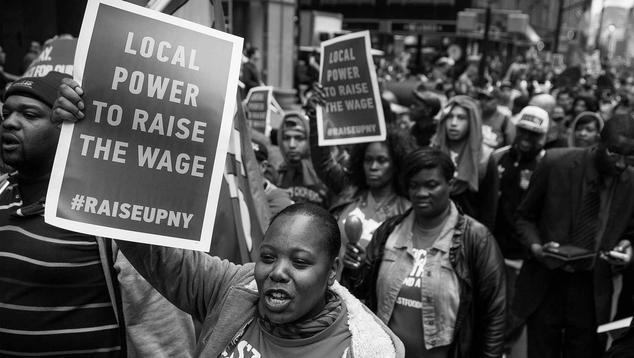Story Highlights
- Percentage who think they are underpaid has not changed since 2010
- Unemployment has been slashed, but wages have been slow to rise
- Most who think they are underpaid are still satisfied with their jobs
WASHINGTON, D.C. -- Forty-three percent of U.S. workers think they are underpaid, 50% say they are paid about right and 5% think they are overpaid. The percentage saying they are underpaid is the same as it was eight years ago, the last time Gallup asked the question -- a time when unemployment was much higher and optimism about the availability of good jobs far lower than it is now.
| August 2008 | August 2010 | August 2018 | |||||||||||||||||||||||||||||||||||||||||||||||||||||||||||||||||||||||||||||||||||||||||||||||||
|---|---|---|---|---|---|---|---|---|---|---|---|---|---|---|---|---|---|---|---|---|---|---|---|---|---|---|---|---|---|---|---|---|---|---|---|---|---|---|---|---|---|---|---|---|---|---|---|---|---|---|---|---|---|---|---|---|---|---|---|---|---|---|---|---|---|---|---|---|---|---|---|---|---|---|---|---|---|---|---|---|---|---|---|---|---|---|---|---|---|---|---|---|---|---|---|---|---|---|---|
| % | % | % | |||||||||||||||||||||||||||||||||||||||||||||||||||||||||||||||||||||||||||||||||||||||||||||||||
| Paid about right | 46 | 53 | 50 | ||||||||||||||||||||||||||||||||||||||||||||||||||||||||||||||||||||||||||||||||||||||||||||||||
| Underpaid | 51 | 43 | 43 | ||||||||||||||||||||||||||||||||||||||||||||||||||||||||||||||||||||||||||||||||||||||||||||||||
| Overpaid | 3 | 4 | 5 | ||||||||||||||||||||||||||||||||||||||||||||||||||||||||||||||||||||||||||||||||||||||||||||||||
| GALLUP | |||||||||||||||||||||||||||||||||||||||||||||||||||||||||||||||||||||||||||||||||||||||||||||||||||
The only other time Gallup asked the question, in August 2008, just over half (51%) said they were underpaid, with 49% saying they were paid about right (46%) or were overpaid (3%). At that time, the U.S. economy was already enmeshed in the Great Recession of 2007-2009, and a worldwide financial crisis was only weeks away.
By August 2010, when the question was asked again, the nation had started climbing out of the recession, but unemployment was still high, and relatively few Americans were optimistic about it being a good time to find a quality job. Those two measures of how U.S. workers are faring have improved greatly over the past eight years.
-
The nation's unemployment rate for July 2018 stands at 3.9%, the third month this year it has been at least that low after having been above 4.0% for the previous 17 years. When Gallup asked the question in early August 2010, the unemployment rate was 9.5%.
-
Only 10% of Americans thought it was a good time to find a quality job in August 2010, compared with 65% now.
In addition, Gallup's national study of employee engagement is currently registering the highest percentage of "engaged" workers -- defined as "those who are involved in, enthusiastic about and committed to their work and workplace" -- in its 18-year history, tying the March 2016 reading of 34%.
Despite those indicators of economic progress over the past eight years, real wage growth for American workers has been tepid. In the years leading up to the recession, hourly wages often increased by 4% annually, but in recent years, increases from year to year have ranged between 2% and 3%. The slow growth of wages provides one possible explanation why Americans are still as likely to feel underpaid now as they did when unemployment was so much higher and optimism about good jobs so much lower.
Economists have offered a number of theories on why a tightening of the job market has not produced stronger growth in wages. Rising benefit costs, a lack of workers with the skills needed in higher-paying jobs and the decline of unions all have been cited as causes.
Many Who Think They Are Underpaid Are Not Unhappy With Their Jobs
Though more than four in 10 workers think they are underpaid, that does not necessarily mean they are unhappy with their jobs. Among those who think they are not paid enough, the vast majority (85%) say they are satisfied with their job, including a third (33%) who say they are "completely satisfied." About half (51%) say they are satisfied with the amount of money they earn. Those who believe they are paid about right are more likely to be satisfied with their pay (98%) and with their job (97%).
But thinking that one is not being paid enough is not closely related to a belief that there are few good job opportunities. More than half (59%) of those who think they are underpaid say it is "a good time to find a quality job in America today."
Bottom Line
Those looking for reasons to believe that the nation's economy is in much better shape than in the 2007-2009 recession can point to the recovery of the housing market, the record-setting gains in the stock market or this year's decades-low unemployment level. When looking specifically at how the nation's workers are faring, however, the record is not so positive. Workers are just as likely now as they were eight years ago to see themselves as underpaid.
A decrease in the percentage of workers who think they are not paid enough would be a welcome sign that workers feel they are getting their fair share of the economy's gains. With so many expressing satisfaction about their jobs and their pay, however, the number who feel underpaid does not seem to be a red flag that American workers are reaching dangerous levels of frustration about wages and salaries.
Survey Methods
Results for this Gallup poll are based on telephone interviews conducted Aug. 1-12, 2018, with a random sample of 533 adults, aged 18 and older, who are employed full or part time, living in all 50 U.S. states and the District of Columbia. For results based on the total sample of national adults, the margin of sampling error is ±5 percentage points at the 95% confidence level.
Each sample of national adults includes a minimum quota of 70% cellphone respondents and 30% landline respondents, with additional minimum quotas by time zone within region. Landline and cellular telephone numbers are selected using random-digit-dial methods.
View survey methodology, complete question responses and trends.
Learn more about how the Gallup Poll Social Series works.

